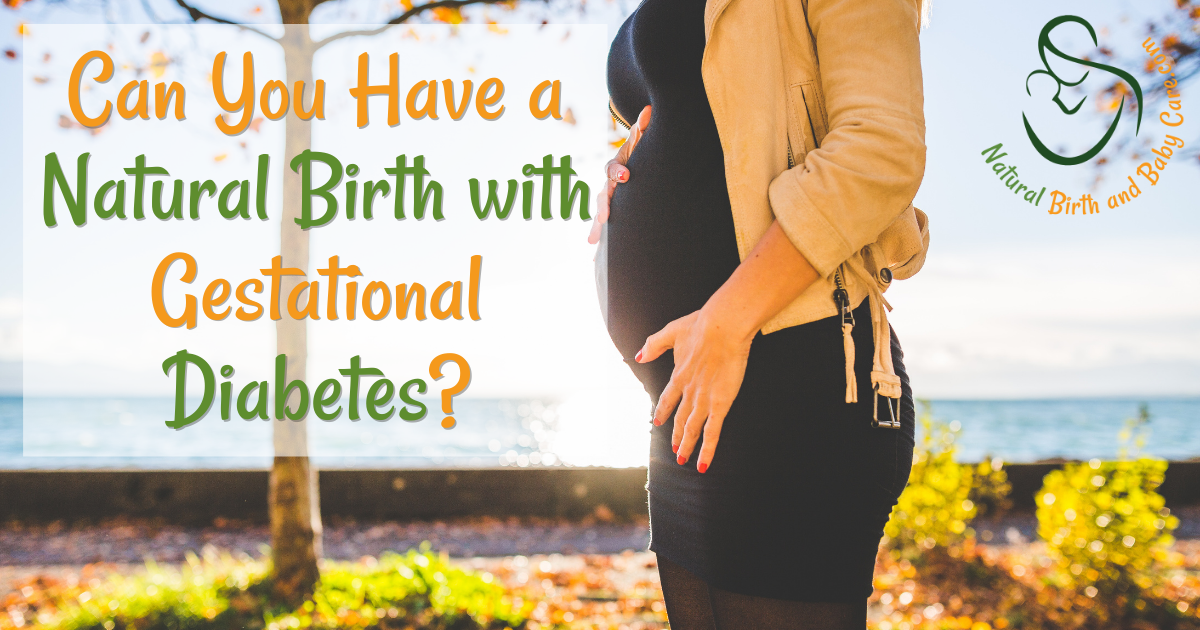
Can You Have a Natural Birth with Gestational Diabetes?
Have you planned a natural birth only to find out you have gestational diabetes? Many women discover they have gestational diabetes and feel confused and scared – how does it impact your baby? Is it still safe to plan a natural birth or is a lot of monitoring and intervention – even a c-section – a given now that you’ve been diagnosed?
Moms with gestational diabetes can have a natural birth. Careful planning and good management of your blood sugar are essential, but the research supports waiting on induction and other interventions, giving you a chance to go into labor naturally and give birth without a lot of procedures. Good control of your sugars keeps both you and your baby safer.
I’ll cover some vital information about gestational diabetes and outline a clear plan to give you the best chance possible of having a natural birth.
What is Gestational Diabetes and What Does it Mean for My Birth and Baby?
Gestational diabetes is a condition that causes high blood sugar levels to rise to levels that aren’t good for you or your baby.
Pregnant women naturally develop some insulin resistance during pregnancy, causing higher blood sugar levels. But there is debate on what level actually constitutes gestational diabetes – veteran midwife and researcher Gail Hart says:
“We’ve known for over a century that women metabolize sugar differently when they are pregnant. Their swings between high and low are larger (it’s one cause of morning sickness) – and the normal blood sugar levels are a bit higher. In controlled circumstances of daily urine testing almost every pregnant woman spills sugar several times during her pregnancy. And we know this is normal. Or at least it used to be believed to be normal.”
Gail continues, “[D]iabetes screening tests developed by some researchers in the last two decades actually propose lower [blood sugar] values than when not pregnant! They reject the view that higher levels are a physiological adaptation of pregnancy and glucose levels are normally elevated in order to provide for the growth of the placenta and fetus.”-Gail Hart
As you can see, there is debate and lack of consensus about what numbers to use for testing during pregnancy and even how to do the testing (it varies depending on where you are in the world).
We do know that pregnant women become insulin resistant as a natural pregnancy adaptation, as Gail says.
Higher Sugars in the Population Overall
But I also feel that some of what we see today is due to a diet that has an overall high level of calories and carbohydrates. Food just wasn’t as plentiful in the past, and women’s bodies were designed to handle that. Today there are pickles and ice cream everywhere 😉
Just like we see more diabetes in the overall population, we see pregnant women with higher blood sugar levels.
We know that gestational diabetes leads to a bigger baby, but lacks the same markers (and risks) for the actual disease diabetes mellitus. About 30% of moms with gestational diabetes have a large baby (note that means that about 70% don’t).
Even if you do show high blood sugar levels, you can bring those levels under control and have a great pregnancy outcome. In her book Real Food for Gestational Diabetes, dietician Lily Nichols says:
“Research has shown us that moms who can bring their blood sugars down to normal have no higher risk of complications than women without the diagnosis. With the right information, gestational diabetes isn’t such a bummer after all.”-Lily Nichols
What About Big Babies?
As I noted above, about 30% of mothers with gestational diabetes will have babies larger than about 9 pounds – these babies have the same risks as other big babies, but not the same risks as mothers who are diabetic before pregnancy.
In other words, gestational diabetes is different. Here are possible issues seen with all larger babies:
Contrary to popular belief, babies born to moms with gestational diabetes do not have the risks seen in babies born to moms with pre-existing diabetes. The primary risk from a big baby is “stuck shoulders” or shoulder dystocia. Please remember that big babies can be born with no problem.
C-Section vs. Vaginal Birth
Some may recommend a c-section if you have gestational diabetes. This is because of the risk of shoulder dystocia, and becomes a more likely issue the longer you go in your pregnancy (since your baby continues to gain weight throughout the pregnancy).
While it’s true that birthing a larger baby carries a slightly increased risk of shoulder dystocia, there are also risks to a cesarean section. Those risks are present for this pregnancy and may also impact future pregnancies and births.
There are positions you can use to deliver a large baby smoothly – these are great to learn now, even though most moms diagnosed with gestational diabetes will not have a very large baby.
Another risk is your baby’s blood sugar levels after birth, however, this is unlikely if your sugar levels are well-controlled by diet. Early and frequent breastfeeding is the best “treatment” for blood sugar issues in your baby. Skin-to-skin contact also regulates newborn blood sugar. Both of these are more likely to happen after a vaginal birth.
Pregnancy Risks
There are some greater risks associated with a pregnancy with gestational diabetes. These risks may not be caused by gestational diabetes, but rather may occur along with gestational diabetes. They are:
The baby is usually full-term – there is no risk of prematurity – though some doctors do like to induce at 38 or 39 weeks (if a baby is born prematurely due to induction, this is called “iatrogenic” or doctor-caused prematurity).
There is also no increased risk of stillbirth with mothers who have gestational diabetes.
Induction vs. Waiting for Labor to Begin
Most moms hoping for a natural birth want to avoid induction because it makes having a birth without further intervention and medication difficult.
But induction is the most common intervention a mother with gestational diabetes will face, so it’s important to know pros and cons.
Aside from a smaller baby, induction at 38 weeks (or earlier) seems to have no positive benefits for mothers or babies – it increases the risks of c-section for both first-time and experienced moms. Babies have higher rates of jaundice, breathing problems, and blood sugar regulation issues.
Induction at 39 weeks is associated with a smaller baby, and a lower risk of c-section for moms. Babies do not seem to have the same increases in risk as 38-week babies – jaundice and other newborn issues seem to be the same in both induced and non-induced babies.
After 40 weeks babies tend to do well, but c-section risk rises for all moms. After 41 weeks, NICU admission rises again.
As mentioned above, the risk of stillbirth does not increase for moms with gestational diabetes, though there is a small increase for everyone after 42 weeks of pregnancy.
Evidence Based Birth has done extensive analysis of these risks v. Benefits in their article on the evidence for induction.
What’s Really Going On With Gestational Diabetes
As I mentioned above, the markers for gestational diabetes are hotly debated and who has GD and who doesn’t is unclear.
Pregnancy naturally causes insulin resistance due to the presence of human placental lactogen. As midwife Gail Hart explains, this is a good adaptation of pregnancy meant to sustain mother, baby, and placenta in good health.
Assuming that a mother who has mild, normal insulin resistance instead has a disease process can cause unwanted interventions for a healthy mother and baby.
At the same time, what is true for overall society is true in pregnancy: we have much greater access to sugary, carbohydrate-heavy foods than people in the past.
It’s my belief that this greatly increases diabetes risks for everyone – and we see that reflected in pregnant moms, too.
The solution is to eat with this knowledge in mind. Be intentional with food choices and minimize sugars and carbs. It’s okay to eat unhealthy foods sometimes… but keep it at “sometimes” 😉
A Quick Note for Healthy, Natural-Minded Mamas
It’s possible for a mom who normally eats lower levels of sugar and carbohydrate to get a false positive on the gestational diabetes screening.
This happens because the screening uses an extremely sugary beverage (called Glucola) which is far, far beyond the level of sugar many conscious moms take in across a day.
It literally causes your body to go crazy trying to handle the sugar load. You may feel awful and your test results may come back very skewed.
If you’re normally lower carb, talk to your care provider about alternative tests (such as testing after a normal breakfast or a slightly more sugary breakfast than you usually eat).
If that’s not possible, increase the amount of carbohydrate you’re eating for a few days leading up to the test.
Steps to Have a Natural Birth with Gestational Diabetes
The steps that follow are evidence-based strategies that work to increase your chances of a natural birth. Most of these are during pregnancy because well-controlled sugar levels result in a healthy, normal pregnancy and the greatest chances of a natural birth for moms.
Diet, Diet, Diet, Diet
What you eat is very important. Pregnant women need a lot of protein and plenty of healthy fats. You also need abundant micronutrients.
An adequate level of calories for pregnancy is much higher than many women are used to – if you’ve been used to eating between 1500-1800 kcal a day, you need to eat more.
2100-2300 kcal is a good rate for most pregnant women, though some women need more (especially if you’re carrying multiples, are under a lot of stress, or if you’re breastfeeding through a pregnancy).
Pregnant women should also get a reasonable level of carbohydrate.
Carbohydrates provide easy energy, which is important when your body is doing so much: growing your baby, supporting the placenta, making amniotic fluid, expanding your blood supply, supporting all the changes in your body, and every day energy needs! Your body is doing a lot, so some carbohydrate is good.
But, as I said above, carbohydrates and sugars are everywhere – sugary drinks, sugary foods, meals that are almost completely grains and starches, etc.
You likely know that sugar, candy, ice cream, grains, potatoes, fruits, and beans are high in carbohydrate, but you may not realize that milk and regular yogurt are as well.
The good news is, lower carbohydrate alternatives are available. For example:
Cheese and Greek yogurt have much lower carbohydrate levels than fluid milk or regular yogurt. Berries are a relatively low-carbohydrate fruit. And many vegetables, including salad greens, cucumbers, broccoli, cauliflower, mushrooms, sweet peppers, and tomatoes (in moderation) are low carb. Olives and nuts can also be enjoyed in moderation.
A complete discussion on how to eat for gestational diabetes is in-depth, but it’s worth doing your research because most women can absolutely control their sugars have not just a healthy, but an extremely healthy pregnancy – through diet alone.
To get started planning a healthy pregnancy diet, listen to my podcast interview with Lily Nichols on gestational diabetes. Then I highly recommend you get Lily’s book, Real Food for Gestational Diabetes. It covers in-depth discussion of gestational diabetes, how to count carbs, how to plan your daily diet, and includes recipes + meal plans.
Conventional advice on diet for gestational diabetes often doesn’t work – check out this video I did for more details on why:
Movement and Exercise
Like healthy diet, plenty of daily movement is critical for all pregnant women – but it’s especially important as you prepare for a natural birth with gestational diabetes.
Movement has many direct benefits for both pregnancy and birth, including:
When moms exercise during pregnancy, their babies have lower risks of obesity, diabetes, and metabolic syndrome.
Exercise also helps control blood sugar:
Incorporate a lot of movement into your day – walking is the ideal first step to a movement-filled life (which will benefit you and your baby throughout life). In particular, walking in nature has a lot of benefits to you (and your baby, once he or she arrives).
Try and make sure you’re up and moving around at least every hour – doing housework, taking a walk around the office building, or getting out for a brisk walk around the block, for example. Find times to squat, bend, and reach to give your body movement variety.
You should also do a more formal exercise routine a few times a week – there are many great prenatal programs to choose from (my favorite is prenatal belly dance to compliment my walking, hiking, and snowshoeing!). Sign up for classes or check out good pregnancy workout DVD’s.
Do be aware that your body changes greatly during pregnancy – and it’s not just that your center of balance shifts. Your body produces a hormone, called relaxin, that causes your joints and ligaments to soften in preparation for birth. Be careful about over-stretching or doing high-impact workout routines – they could cause injuries that wouldn’t happen when you’re not pregnant.
Preparation for Birth
When you work on your diet and add movement and exercise into your day, you’ve gone a long way towards having a great natural birth.
But preparing specifically for your birthing time boosts your chances of a natural birth.
Take a prepared natural childbirth class (skip the hospital classes and take a quality class that teaches real skills and techniques for natural childbirth). My online MamaBaby Birthing childbirth class is a great option – shoot me an email after you order and I’ll include my gestational diabetes class with your MamaBaby Birthing videos.
Other options, like Hypnobabies or in-person Bradley classes, are also good.
Don’t just go through your class materials once and forget them until labor begins – actually practice the breathing techniques, try out different positions, and get to know the skills and techniques. They’ll be much more natural to use during birth if you’re families with them.
Be Ready to Use Your Skills Along with Interventions
It’s more likely that your doctor or midwife will insist on monitoring if you’re laboring with gestational diabetes.
You should still advocate for yourself, especially in regards to mobility – moving during labor is important. An upright, active position lines up baby and brings him or her down faster.
If your doctor wants more monitoring, request 20 minutes on the monitor every hour, supplemented with regular checks via hand-held Doppler between monitoring periods. If at all possible, refuse continuous monitoring that leaves you stuck in bed.
If you plan for the increased monitoring, you can also plan on using techniques and methods that help you work with reduced mobility during monitoring periods.
Consider bringing tools, like a birth ball, that help you create movement in a small space and also give you a soft place to sit and rest (while still being upright) – start using a birth ball to sit on during your pregnancy so you’re used to it.
How to Give Birth if You’re Worried About a Big Baby
What if you hear that your baby is going to be big?
Or…
…Really. Big.
Is there anything you can do to still have a natural, vaginal birth?
Here’s the truth – labor is going to feel the same with a big baby or a small baby. You can handle it, mama 😀 If you’re worried about the pain of labor, check out my labor pain class – it’s a focused class session that walks you through the nitty-gritty of handling labor pain.
Pushing out a big baby can be intense – I’ve had two bigger babies, a 9lb baby girl and a 10lb, 10oz baby boy. My girl slipped out pretty peacefully but my big boy was very intense – he came fast and smoothly but I roared him into the world!
Check out my article on handling the “ring of fire” for tips on how to prepare for the intensity of pushing your baby out.
The key to smoothly pushing out a big baby is position. I highly caution you against pushing out a big baby in the common semi-sitting position! That position has gravity working against you and it pushes your tailbone up against your baby.
These positions are optimal:
I gave birth to both of my big babies while kneeling in the birthing tub – and I brought them up myself after pushing them out <3
Standing is a great position because gravity is totally in your favor and your baby is lined up well for delivery.
The hands and knees position is a win-win for you and your care provider team – it’s a comfortable, solid position for you and it opens up your pelvis for your baby. It also gives your care provider a great view of the birth and plenty of space if they need to help your baby out.
In fact, if you do end up in the semi-sitting position to birth and things seem slow, your birth team may have you flip to hands and knees. Many moms like birthing in this position.
After Baby Arrives
Earlier in the article I shared that some big babies can have trouble with blood sugar once they’re born. This is far less likely if you’ve controlled your own blood sugar effectively through diet.
However, you can take steps to make sure your baby’s blood sugar stays at good levels after birth:
Your body is incredible – you’ve grown and nourished your baby, and now you’ve birthed your baby! Your miraculous mama body doesn’t stop there, though…
…being skin-to-skin with your baby actually regulates your baby’s body systems. Your body temperature adjusts to keep your baby safe and comfortable…
…and being skin-to-skin with you literally regulates your baby’s blood sugar levels. It’s pretty incredible how interconnected mama and baby are, even after birth (it’s part of why I decided to name my course MamaBaby Birthing <3)
Breastfeeding your baby right away helps get nutrition into his or her body, and breastfeeding often keeps blood sugar levels regulated well. Some babies take time to breasfeed the first time (up to about 60 minutes after birth is normal), but having your baby nuzzling and licking while skin-to-skin on your chest is a great start.
You also need to eat well – in fact, you’ll probably be ravenous after birth. Good, nourishing food helps your body begin the transition to breastfeeding mama and keeps your sugars stable, too.
Related Questions
What is a natural cure for gestational diabetes?
While officially there may be no “cure” for gestational diabetes, you can control your blood sugar levels naturally, and most of the time completely, through diet. Older gestational diabetes diet advice is outdated and doesn’t, but following a lower carbohydrate diet rich in nutrients and protein like I outline above does work. Regular prenatal exercise is also essential.
Can a healthy person get gestational diabetes?
All pregnant women are naturally insulin resistant – it’s an adaptation of pregnancy to make sure the baby and placenta get the energy they need. But today’s easy access to carbohydrates can cause problems when mixed with this natural insulin resistance – even in healthy moms. It’s best to follow a nourishing pregnancy diet like I discuss above to prevent gestational diabetes.
Do you need to be induced with gestational diabetes?
While many care providers induce for gestational diabetes, it’s not necessary. With well-controlled blood sugar levels, most moms will not have a very big baby. While the risk of cesarean does increase after 40 weeks for a mom with gestational diabetes, it actually increases for all pregnant women. Good childbirth preparation and pushing positions get you ready to birth your strong, healthy baby smoothly. See my tips above for more details on pushing your baby out safely.



